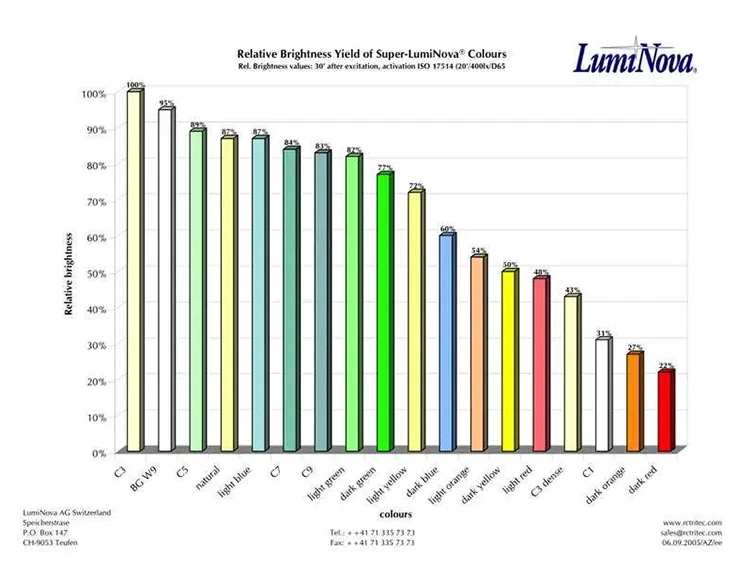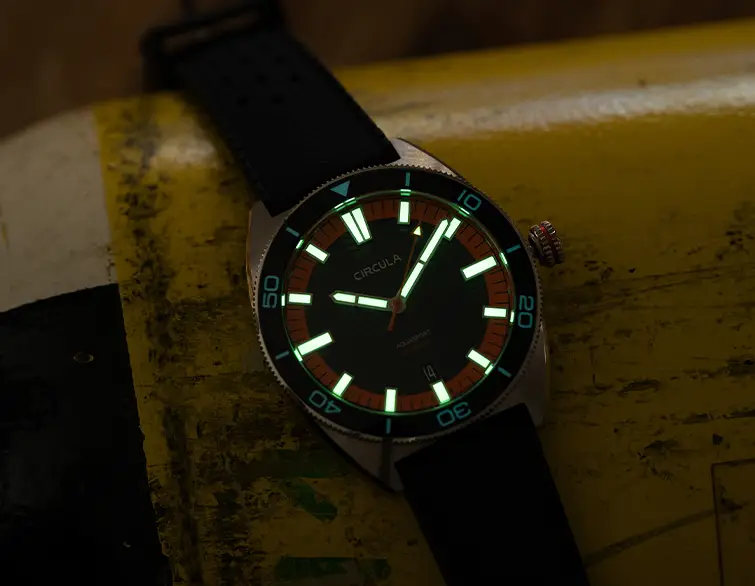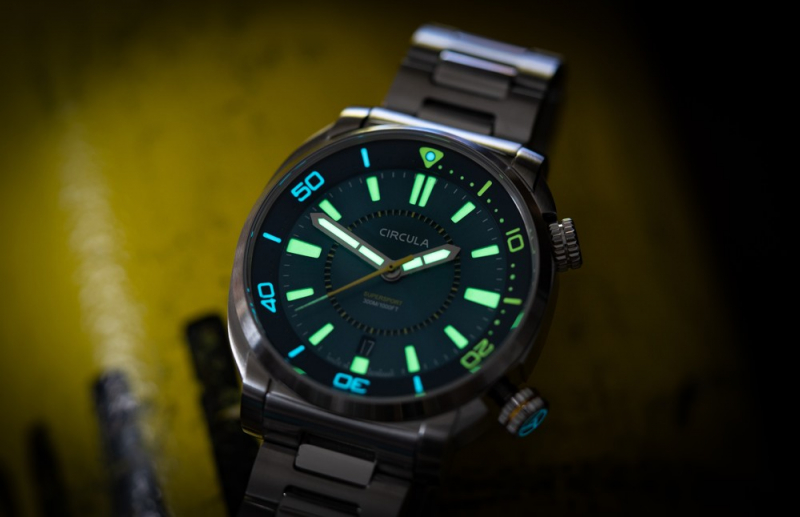Super-LumiNova®
und die Uhr leuchtet!
Was ist Super-LumiNova®?
Super-LumiNova® sind nachleuchtende Pigmente (nicht nachtleuchtende Pigmente!) auf Erdalkali-Aluminat-Basis, die ähnlich wie kleine Lichtspeicherbatterien funktionieren. Ist von Super-Luminova die Rede, dann handelt es sich meist um Swiss Super-LumiNova® der Schweizer Firma RC TRITEC AG, welches zu 100 % in der Schweiz hergestellt und vor allem von der Schweizer Uhrenindustrie eingesetzt wird.
Damit die Pigmente auf Uhren aufgetragen werden können, müssen sie mit Lack als Trägerschicht vermischt werden. Anschließend können sie mittels eines Belegungsstifts, dem sogenannten Stylograph, Siebdruck oder Transfer-/Tampondruck auf Zeiger, Indizes und Lünette aufgetragen werden.
Eigenschaften von Super-LumiNova®
Im Gegensatz zu den Vorgängern Radium und Tritium ist Super-LumiNova® nicht radioaktiv. Es ist außerdem REACH-kompatibel (also gesundheitlich unbedenklich), temperaturresistent und unempfindlich gegen Umwelteinflüsse – sofern es korrekt aufgetragen wurde.
Haltbarkeit von Super-LumiNova®
Die Leuchtpigmente lassen sich sowohl mit Tageslicht als auch mit künstlichem Licht (z.B. von einer Taschenlampe) aufladen und geben dann die gespeicherte Lichtenergie kontinuierlich ab, d.h., dass das Nachleuchten immer schwächer wird, bis die Uhr erneut mit Tages- oder Kunstlicht aufgeladen wird. Der Aufladevorgang selbst lässt sich unendlich oft wiederholen, da Super-LumiNova® nicht abnutzt und über die Jahre auch nicht an Leuchtkraft verliert. Um ein gutes Ergebnis beim Auftragen der Leuchtpigmente zu erhalten, müssen verschiedene Dinge beachtet werden, wie z.B. das richtige Mischungsverhältnis von Lack und Pigmenten, die Umgebungstemperatur, die Auftragungsdicke, die Art der Trocknung (backen oder an der Luft), das Auftragen einer zweiten Schicht oder auch, wie Zeiger, Indizes oder Ziffern vor dem Auftrag der Leuchtmasse gereinigt wurden.
Super-LumiNova® Leuchtdauer
Je nachdem, wie intensiv die Leuchtpigmente aufgeladen werden, können diese ein paar Minuten oder die ganze Nacht über leuchten. Wenn die Leuchtmarkierungen in ausreichender Größe und Masse aufgetragen wurden, dann ist eine einwandfreie Ablesbarkeit über die ganze Nacht nach ISO 3157 garantiert. Wie dick die Leuchtmasse aufgetragen wurde hat übrigens keinen Einfluss auf die Leuchtdauer – es handelt sich um ein rein optisches Gestaltungsmittel, da Ziffern und Indizes durch mehrschichtiges Auftragen plastischer wirken.
Super-LumiNova® Grade
Die verschiedenen Qualitätsstufen (engl. Grade) beziehen sich auf die Nachleuchtkraft und die Leuchtdauer. Super-LumiNova® ist in drei verschiedenen Qualitäten erhältlich: Standard Grade Grade A Grade X1 Der Standard Grade hat die kürzeste Leuchtdauer und X1 die längste. Grade X1 lässt sich leichter aktivieren und leuchtet nach zwei Stunden noch 60 % heller als Grade A.
Die gängigsten Farbvarianten
Super-LumiNova® C3
C3 ist bei Tageslicht gelblich und leuchtet im Dunkeln grün. Mit einer relativen Leuchtkraft von 100 % ist C3 das hellste Super-LumiNova®. Wir verwenden C3 für die Zeiger und Indexe der Circula AquaSport Automatik. In der 2. Generation der AquaSport setzen wir ebenfalls C3 ein, allerdings in der höchsten Qualitätsstufe X1.
Super-LumiNova® BG W9
BG W9 ist bei Tageslicht weiß und leuchtet im Dunkeln grün-blau. Die Bezeichnung BGW setzt sich aus den englischen Farbbezeichnungen zusammen: blue green white. Im Vergleich zu C3 hat BG W9 eine Leuchtkraft von 95 %.
Super-LumiNova® C1
C1 ist bei Tageslicht weiß und leuchtet im Dunkeln grün. Mit einer Leuchtkraft von 31 % im Vergleich zu C3 ist C1 sehr dezent.
Super-LumiNova® Old Radium
Old Radium ist bei Tageslicht hellorange bis bräunlich und leuchtet im Dunkeln grün.

Trotz der großen Farbauswahl (blau, grün, violett, weiß, gelb, orange, pink…) werden für Uhren meist Super-LumiNova® in Grün- und Blautönen verwendet. Das hat den Hintergrund, dass das menschliche Auge grünes Nachleuchten am besten erkennen kann, wenn man vom Tageslicht in einen dunklen Raum kommt. Hat sich das Auge an die Dunkelheit gewöhnt, dann ist blaues Nachleuchten besser erkennbar.
Für die Circula AquaSport II nutzen wir daher z.B. Swiss Super-LumiNova® C3 X1 für die Zeiger und Indizes, sowie BGW9 für die Markierungen auf der Lünette. Bei der SuperSport ist es genau umgekehrt.

Die Vorläufer von Super-LumiNova®
Früher, zu Beginn des 20. Jahrhunderts bis in die 60-er Jahre, wurden radioaktiven Stoffe auf Basis von Radium genutzt, um Armbanduhren zum Leuchten zu bringen. Diese strahlten dann zwar kontinuierlich und ohne aufgeladen werden zu müssen, jedoch ging (und geht auch heute noch aufgrund der langen Halbwertszeit von 1622 Jahren!) eine ungesund hohe radioaktive Strahlung von der Beschichtung aus.
Ende der 50-er Jahre wurde dann anstelle von Radium schwach radioaktive Isotope wie Tritium und Promethium genutzt, die eine Halbwertszeit von lediglich 12,5 Jahren haben und deren Strahlen die Metallgehäuse und Gläser von Uhren nicht durchdringen können.
1973 entwickelte die japanische Firma Nemoto & Co. schließlich ein lang nachleuchtendes phosphoreszierendes Pigment auf Basis von radioaktiv aktivierten Zinksulfiden.
Erst 1993 gelang es Nemoto & Co. das phosphoreszierende und gänzlich nicht radioaktive Pigment LumiNova® zu entwickeln. Im Gegensatz zu den phosphoreszierenden Pigmenten auf Zinksulfidbasis waren diese Pigmente zehnmal heller und leuchteten auch zehnmal länger nach. Innerhalb weniger Jahre ersetzte LumiNova Leuchtfarben, die radioaktive Materialien verwendeten.
1998 schloss sich Nemoto mit der Schweizer Firma RC-Tritec zusammen, um dort für die Schweizer Uhrenindustrie hochwertige Nachleuchtpigmente, nämlich Swiss Super-LumiNova® zu fertigen.

